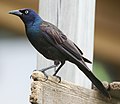The avian genus Quiscalus contains seven of the 11 species of grackles, gregarious passerine birds in the icterid family. They are native to North and South America.
| Quiscalus | |
|---|---|

| |
| Common grackle (Quiscalus quiscula) | |
| Scientific classification | |
| Domain: | Eukaryota |
| Kingdom: | Animalia |
| Phylum: | Chordata |
| Class: | Aves |
| Order: | Passeriformes |
| Family: | Icteridae |
| Genus: | Quiscalus Vieillot, 1816 |
| Type species | |
| Gracula quiscula[1] Linnaeus, 1758
| |
| Species | |
| |
The genus was named and described by French ornithologist Louis Pierre Vieillot in 1816.[2] The type species was subsequently designated as the common grackle (Quiscalus quiscula) by English zoologist George Robert Gray in 1840.[3][4] The genus name comes from the specific name Gracula quiscula coined by Swedish naturalist Carl Linnaeus for the common grackle.[5] From where Linnaeus obtained the word is uncertain, but it may come from the Taíno word quisqueya, meaning "mother of all lands", for the island of Hispaniola.[6]
The genus contains six extant species and one extinct species:[7]
| Image | Scientific name | Common name | Distribution |
|---|---|---|---|
 |
Quiscalus major | Boat-tailed grackle | Florida and the coastal Southeastern United States |
 |
Quiscalus quiscula | Common grackle | North America |
 |
Quiscalus mexicanus | Great-tailed grackle | northwestern Venezuela and western Colombia and Ecuador in the south to Minnesota in the north, to Oregon, Idaho, and California in the west, to Florida in the east, with vagrants occurring as far north as southern Canada |

|
†Quiscalus palustris | Slender-billed grackle | endemic of central Mexico, namely Valley of Mexico and Toluca Valley (extinct around 1910) |
 |
Quiscalus nicaraguensis | Nicaraguan grackle | Nicaragua and northernmost Costa Rica |
 |
Quiscalus niger | Greater Antillean grackle | the Greater Antilles |
 |
Quiscalus lugubris | Carib grackle | Colombia east to Venezuela and northeastern Brazil |
References
edit- ^ "Icteridae". aviansystematics.org. The Trust for Avian Systematics. Retrieved 2023-07-16.
- ^ Vieillot, Louis Pierre (1816). Analyse d'une Nouvelle Ornithologie Élémentaire (in French). Paris: Deterville/self. p. 36.
- ^ Gray, George Robert (1840). A List of the Genera of Birds : with an Indication of the Typical Species of Each Genus. London: R. and J.E. Taylor. p. 41.
- ^ Paynter, Raymond A. Jr, ed. (1968). Check-list of Birds of the World. Vol. 14. Cambridge, Massachusetts: Museum of Comparative Zoology. p. 187.
- ^ Linnaeus, Carl (1758). Systema Naturae per regna tria naturae, secundum classes, ordines, genera, species, cum characteribus, differentiis, synonymis, locis (in Latin). Vol. 1 (10th ed.). Holmiae (Stockholm): Laurentii Salvii. p. 109.
- ^ Jobling, James A. (2010). The Helm Dictionary of Scientific Bird Names. London: Christopher Helm. pp. 328–329. ISBN 978-1-4081-2501-4.
- ^ Gill, Frank; Donsker, David, eds. (2019). "Oropendolas, orioles, blackbirds". IOC World Bird List Version 9.2. International Ornithologists' Union. Retrieved 4 September 2019.
External links
edit- Quiscalus videos, photos and sounds on the Internet Bird Collection